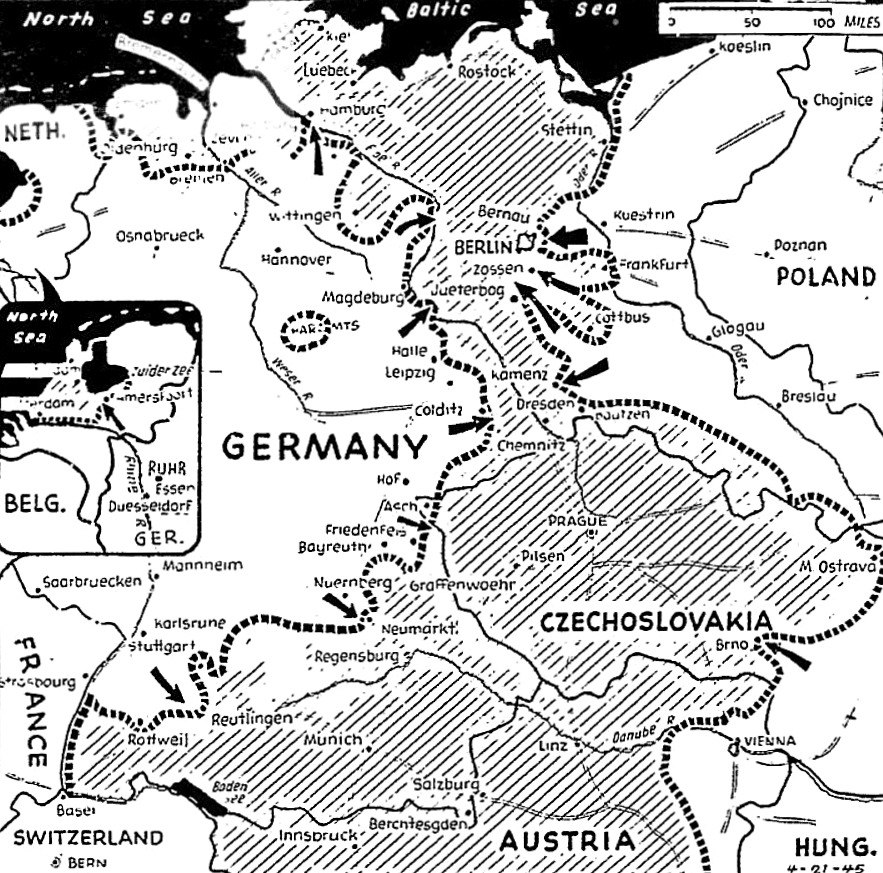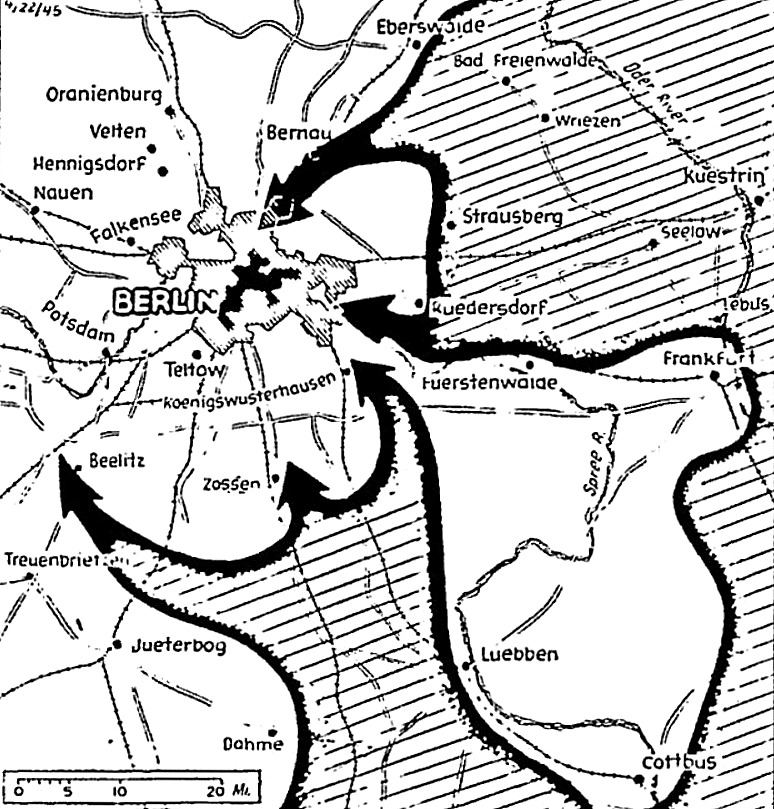The Pittsburgh Press (April 20, 1945)
Reds 7 miles from Berlin
Soviet tanks smash into defenses before burning Nazi capital
BULLETIN
LONDON, England – A special message broadcast by Supreme Allied Headquarters tonight to Russian and Polish nationals in the corridor between the Russians and Anglo-American armies told them to stay where they were, because the gap would be closed “in a few days more.”
LONDON, England (UP) – Russian assault forces smashed into Berlin’s “defense zone proper” within seven miles of the city today.
Moscow said U.S. and Russian patrols probably had made a juncture in the Dresden area.
A Nazi military spokesman said massed Soviet tanks and troops had penetrated into Hangelsberg, seven miles east of Berlin on the trunk highway to Frankfurt, and had reached the defenses of the burning capital.
The German High Command, acknowledging widespread reverses in the fortifications in front of Berlin, said frankly that “the situation has deteriorated.”
Other Nazi broadcasts reported Soviet tanks and infantry were moving directly against Berlin between Muencheberg and Wriezen, 16 miles east and 23 miles northeast of the capital. Their center had reached Strausberg, nine miles from the capital, and the lower wing was at Hangelsberg.
Moscow dispatches, following up the first Soviet High Command confirmation of the showdown offensive on a broad Berlin front, reported that the Russians had broken across the Spree River and were closing against Dresden.
It was in that region that, according to a Moscow dispatch, outriders of Lt. Gen. George S. Patton’s U.S. Third Army and Marshal Ivan S. Konev’s First Ukrainian Army, probably have met.
Today’s Nazi communiqué said that another breach had been torn in the southeastern wing of Berlin’s outer defenses. It said the Russians crashed through south of Cottbus, 53 miles from Berlin, and broke into Calau, 48 miles south of the capital. Vetschau, five miles northeast of Calau, was also reached.
The Nazi command claimed that in the Goerlitz-Bautzen-Weisswasser penetration south of Cottbus the Russians were checked. but acknowledged heavy Russian attacks on either side of Spremberg, 14 miles southeast of Cottbus.
The German High Command’s account of the battle before Berlin was heavy with gloom. On either side of Frankfurt, it said, the “gallantly fighting German divisions scored full defensive successes.”
But on the vital Muencheberg-Wriezen sector where the frontal assault against Berlin was being pushed, the Germans admitted the Russians had advanced. The high command said the Red Army reached the area of Templeberg, four miles south of Muencheberg, and Bucholz, three miles farther southwest. Other reports of advances to Hangelsberg and Strausberg superseded the communiqué.
The Wriezen wing of Berlin’s defenses had also fallen back. The Nazi command said Soviet reserves and tanks pushed to Sternbeck, seven miles southwest of Wriezen, and Proetzel, 2½ miles southwest of Sternbeck.
The first Moscow reports after the Soviet High Command’s confirmation of the great offensive said Berlin was being invested from three directions and that Russian guns were hammering the city’s inner defenses.
The first report of a possible junction of the American and Russian forces came from Moscow. United Press writer Henry Shapiro reported from the Soviet capital that Russian forces, after breaking through the Spree River defense line, were thrusting on toward a junction with the U.S. Third Army forces advancing on Dresden.
“In the Dresden sector, motorized Soviet patrols probably already have contacted the scouts of Lt. Gen. George S. Patton,” Mr. Shapiro reported.
In any event, the Moscow dispatch said, giant Stalin and Sherman tanks surging westward from the crumbled Spree line can easily exchange radio greetings with the Americans.
Soviet field reports referred to Marshal Konev’s First Ukrainian Army units “closing in on Dresden.” But by Nazi account the closest approach to the Saxony capital was at Bautzen, 25 miles northeast.
U.S. Third Army forces were 30-odd miles from Dresden at last report, and it was evident that any such patrol junction as Moscow suggested would be important mainly for its symbolism of an east-west meeting and the collapse of the German defenses In the Dresden region.
Mr. Shapiro reported that after the Red Army’s modest announcement of the expansion of bridgeheads across the Oder before Berlin and beyond the Neisse to the southeast, masses of army groups were swarming over both rivers for “a great enveloping operation circumscribing the arc of the capital.”
Russian field dispatches said Berlin had been burning ceaselessly for the last few days, the towering columns of smoke and leaping sheets of flame in plain sight of the Russian siege forces chopping through its maze of defenses.
More details near
“More details of the three army groups smashing westward between Stettin and Dresden are expected to be announced at any time,” Mr. Shapiro reported.
Ernest Hammer, Nazi military commentator, said the battle before Berlin had reached a peak of fury, with guns blazing incessantly and bombers lashing the German positions.
“In the course of extremely fierce fighting, the Germans intercepted a massive assault of Soviet tanks which was heading directly for Berlin along the Muencheberg-Bukow-Wriezen front,” Hammer said.
Frankfurt menaced
He reported “fanatic resistance” on both sides of Frankfurt, indicating that the Oder River bastion 33 miles east of Berlin had been isolated by the Soviet push westward.
Hammer said a Russian tank column broke through north of Goerlitz, on the Neisse 106 miles southeast of Berlin, and thrust toward Bautzen. A Nazi military spokesman said yesterday the line ran through Bautzen on the Spree.
The Nazis said the Russians had pushed at least eight miles beyond the Spree to the edge of Hoyerswerda, 70 miles below Berlin.
Gain on 100-mile front
The Soviet High Command last night belatedly confirmed that the Russian “central army groups” had attacked across both the Oder and Neisse Rivers on a 100-mile front four days ago, but claimed for the moment only that they were expanding bridgeheads across both streams.
Two Polish armies under Gen. Michal Rola-Zymierski were participating in the offensive, the Russians said, one on the Berlin front and the other across the Neisse.
The Soviet communiqué announced that the Russians had crossed the Neisse River, a tributary of the Oder, on a 32-mile front and captured Forst, 60 miles southeast of Berlin; Muskau, 15 miles farther south. and Weisswasser, another three miles to the south.
Polish Second Army troops on the southern flank captured Rothenberg, 32 miles south of Forst, the Russians announced. A Warsaw communiqué said the Poles had invaded Germany from the “new Polish state frontier” – indicating that Poland intended to claim the Neisse as her post-war frontier with the Reich.
Gain in Czechoslovakia
German broadcasts, going far beyond the Soviet announcement, said the Red Army had driven 32 miles beyond the Neisse River to reach Hoyerswerda on the west bank of the Spree.
Farther south, the Nazis said, Russian forces reached Bautzen, 27 miles west of Rothenberg.
Marshal Rodion Y. Malinovsky’s Second Ukrainian Army straightened its lines along a 23-mile front in Czechoslovakia with the capture of Nasedlovice, 10 miles southeast of Austerlitz and 30 miles southeast of Brno.
The Second Army also captured the eastern and western approaches to a five-mile-long railway causeway across the Morava River valley some 15 miles east of Nasedlovice.
In Austria, the Second Army captured Bernhardsthal, one mile south of the Czechoslovak border, and Asparn, 24 miles north of Vienna.


